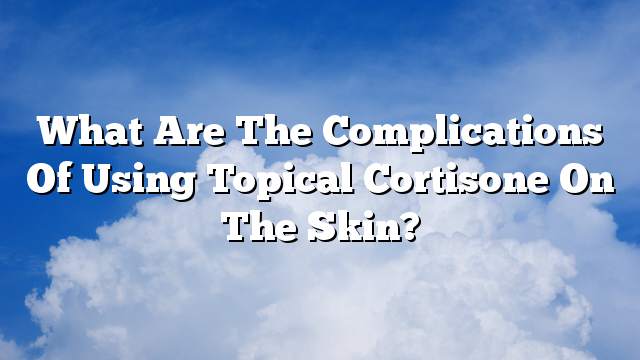Cortisone topical
Corticosteroids are basically naturally occurring hormones in the human body from the adrenal gland. For topical cortisone, it is a group of synthetic corticosteroids used to treat multiple skin conditions such as skin rash, dermatitis (Dermatitis), itching, eczema, psoriasis, and other skin conditions. Topical corticosteroids have an effective anti-inflammatory effect and inhibit the immune response.
Complications of the use of topical cortisone and its side effects
Prolonged use of topical cortisone may lead to many side effects and complications, most notably skin Atrophy. Although all topical corticosteroids may cause skin atrophy, the use of high-efficacy cortisone and skin clogging , Thin skin, and increased patient life increase the chance of skin atrophy.
The areas most prone to skin atrophy are the face, the back of the hands and the folds of the skin. This can be removed by stopping treatment, but it may take up to several months. The use of Topical Tretinoin in conjunction with the use of topical cortisone may reduce the risk of skin atrophy. Tretinoin is a type of medication used to treat acne, which affects the growth of skin cells, reduces pimples, accelerates healing and staining. .
The use of topical cortisone may cause telangiectasia, skin lines and cracks (Striae), and may contribute to a skin condition called Rosacea, a chronic condition in the skin. The first is the facial complexion, which causes redness on the nose, chin, chin and forehead. Sometimes it may glow and sometimes go away. Improper use of topical corticosteroids when treating bacterial and fungal infections may affect Superficial Infection. Cortisone is in conflict with the normal course of inflammation, leading to increased bacterial and fungal infections.
The use of high-efficacy corticosteroids may cause tinea, a skin fungal infection that begins with a reddening of the skin, which can lead to flaking, skin bubbles, and other symptoms that may reach the deep tissue (in English: Deep Tissue (Tinea) is called Majocchi granuloma, an inflammation that occurs in the hair follicle or dermis surrounding the hair and is often caused by skin fungi. Side effects of topical corticosteroids include an increase in pigmentation or hypoglycemia, increased hair growth, acne, and photosensitization. Light sensitivity is the appearance of a rash caused by an abnormal reaction between rays The sun and chromophore in the skin.
Proper use of topical cortisone
You should know the types of topical corticosteroids through the question of the specialist and the therapist, in order to choose the appropriate therapeutic recipe to increase effectiveness and reduce the side effects, and the most important factors that help to choose the right is accurate and correct diagnosis of the case, and knowledge of efficacy and therapeutic capacity of the drug, and the composition of medication, , Duration of use, knowledge of the side effects, history of the patient, in addition to the area to be used cortisone.
Fingertip unit is used to determine the amount of cortisone in which it is used. One unit represents the amount of cream extracted from the medicine tube on the inner end of the index finger. The amount varies according to age, and the different part of the body to be used Drug it. Emollients can be used before or after the use of topical corticosteroids as a buffer or to reduce irritation and dehydration.
It is important to keep in mind that children usually need a shorter treatment period. Corticosteroids should be used less effectively. It is also recommended to go to a skin specialist in cases where the diagnosis is unclear, when basic and standard treatments fail, Allergy patch test is not available at the doctor’s office.
Types of topical corticosteroids
The types of topical corticosteroids according to their pharmacological and therapeutic capacity are divided into four sections, as follows:
- Corticosteroids with very high potency: such as Betamethasone Dipropionate Diprolene, Diflorasone Diacetate, Fluocinonide, and others.
- Corticosteroids with high potency: Amcinonide, Desoximetasone, Halcinonide, and others.
- Corticosteroids with moderate potency: such as Betamethasone Valerate, Clocortolone Pivalate, Fluorandrenolide, and others.
- Corticosteroids with low potency: Desonide, Hydrocortisone, and others.
The drug substance in addition to the type of cortisone used affects the strength of the drug more than the effect of the proportion of the drug contained in the carrier. In general, the use of the drug itself is more effective in ointments, followed by creams, It is worth mentioning that the ointments have a fatty formula, and the percentage caused by burning or racing when used a few. In addition to the ointments, there are modern pharmaceutical preparations can also be used, such as sprays, solutions, and gel are more complex in their composition, some less effective, and It is more effective than creams and lotions.
